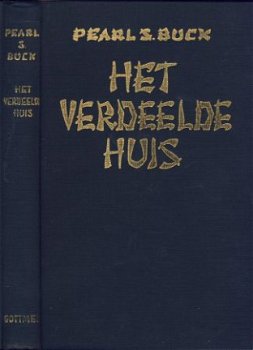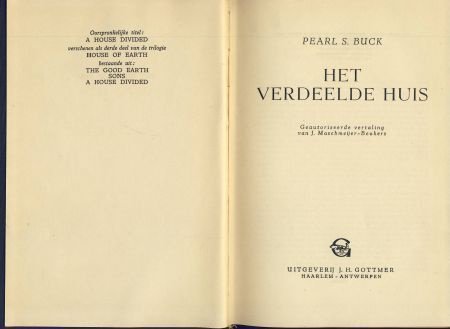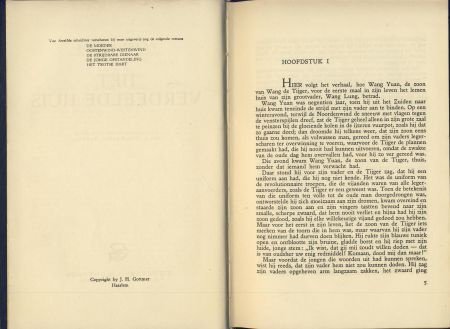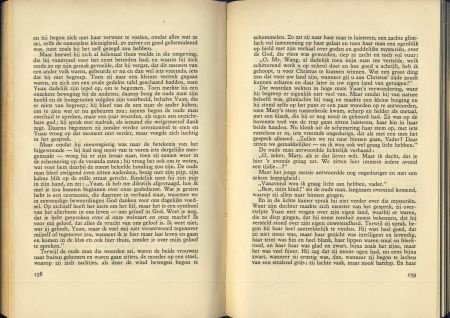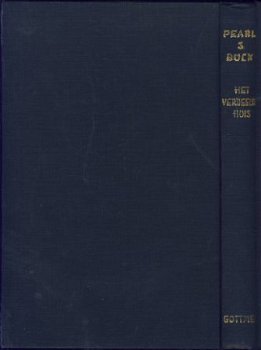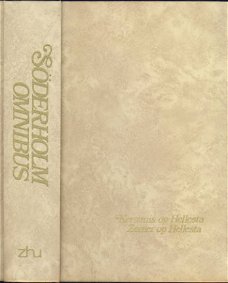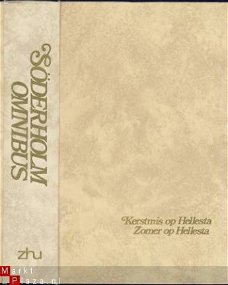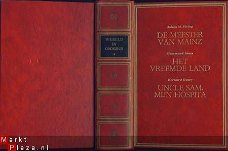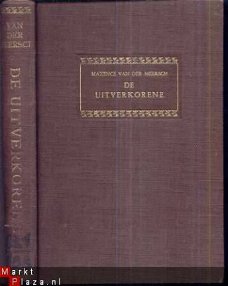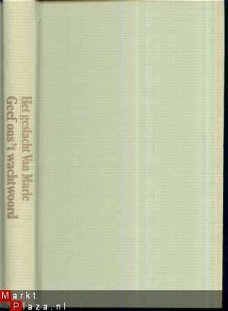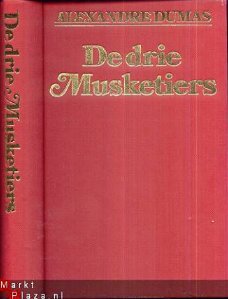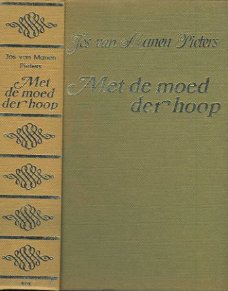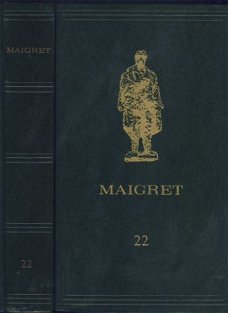
PEARL S. BUCK**HET VERDEELDE HUIS**LINNEN BOEKBAND
Kenmerken
- Conditie
- Gebruikt
- Levering
- Niet van toepassing
Omschrijving
PEARL S. BUCK
**HET VERDEELDE HUIS**
**A HOUSE DIVIDED**
VERSCHENEN ALS DERDE DEEL VAN DE TRILOGIE
****HOUSE OF EARTH****
1.THE GOOD EARTH
2.SONS
3.A HOUSE DIVIDED
GEAUTORISEERDE VERTALING van BEP ZODY
FRISSE ZWARE TEXTUUR LINNEN BOEKBAND.!!
UITGEVERIJ J.H. GOTTMER HAARLEM-ANTWERPEN
ZWARE SOLIDE LINNEN BOEKBAND + ZWAAR PAPIER!!
ARTIKELINVENTARIS CODE 17.204
FORMAAT 221 X 147 X 22 + 210 PGS + 504 GRS.
VERZENDING IN BELGIE 5,50 EURO NR NEDERLAND 8,50 EURO.
**NO MATTER HOW OLD YOU GET, IF YOU CAN KEEP THE DESIRE TO BE CREATIVE YOU ARE KEEPING THE MAN-CHILD ALIVE.** dixit CASAVETES
**THE GREAT CREATIVE INDIVIDUAL IS CAPABLE OF MORE WISDOM
AND VIRTUE THAN COLLECTIVE MAN CAN EVER BE.**
dixit JOHN STUART MILL (1806-1873 )
Pearl Sydenstricker Buck,
1892 - 1973
Pearl Comfort Sydenstricker was born on June 26, 1892, in Hillsboro, West Virginia. Her parents, Absalom and Caroline Sydenstricker, were Southern Presbyterian missionaries, stationed in China. Pearl was the fourth of seven children (and one of only three who would survive to adulthood). She was born when her parents were near the end of a furlough in the United States; when she was three months old, she was taken back to China, where she spent most of the first forty years of her life.
The Sydenstrickers lived in Chinkiang (Zhenjiang), in Kiangsu (Jiangsu) province, then a small city lying at the junction of the Yangtze River and the Grand Canal. Pearl's father spent months away from home, itinerating in the Chinese countryside in search of Christian converts; Pearl's mother ministered to Chinese women in a small dispensary she established.
From childhood, Pearl spoke both English and Chinese. She was taught principally by her mother and by a Chinese tutor, Mr. Kung. In 1900, during the Boxer Uprising, Caroline and the children evacuated to Shanghai, where they spent several anxious months waiting for word of Absalom's fate. Later that year, the family returned to the US for another home leave.
In 1910, Pearl enrolled in Randolph-Macon Woman's College, in Lynchburg, Virginia, from which she graduated in 1914. Although she had intended to remain in the US, she returned to China shortly after graduation when she received word that her mother was gravely ill. In 1915, she met a young Cornell graduate, an agricultural economist named John Lossing Buck. They married in 1917, and immediately moved to Nanhsuchou (Nanxuzhou) in rural Anhwei (Anhui) province. In this impoverished community, Pearl Buck gathered the material that she would later use in The Good Earth and other stories of China.
The Bucks' first child, Carol, was born in 1921; a victim of PKU, she proved to be profoundly retarded. Furthermore, because of a uterine tumor discovered during the delivery, Pearl underwent a hysterectomy. In 1925, she and Lossing adopted a baby girl, Janice. The Buck marriage was unhappy almost from the beginning, but would last for eighteen years.
From 1920 to 1933, Pearl and Lossing made their home in Nanking (Nanjing), on the campus of Nanking University, where both had teaching positions. In 1921, Pearl's mother died and shortly afterwards her father moved in with the Bucks. The tragedies and dislocations which Pearl suffered in the 1920s reached a climax in March, 1927, in the violence known as the "Nanking Incident." In a confused battle involving elements of Chiang Kai-shek's Nationalist troops, Communist forces, and assorted warlords, several Westerners were murdered. The Bucks spent a terrified day in hiding, after which they were rescued by American gunboats. After a trip downriver to Shanghai, the Buck family sailed to Unzen, Japan, where they spent the following year. They then moved back to Nanking, though conditions remained dangerously unsettled.
Pearl had begun to publish stories and essays in the 1920s, in magazines such as Nation, The Chinese Recorder, Asia, and Atlantic Monthly. Her first novel, East Wind, West Wind, was published by the John Day Company in 1930. John Day's publisher, Richard Walsh, would eventually become Pearl's second husband, in 1935, after both received divorces.
In 1931, John Day published Pearl's second novel, The Good Earth. This became the best-selling book of both 1931 and 1932, won the Pulitzer Prize and the Howells Medal in 1935, and would be adapted as a major MGM film in 1937. Other novels and books of non-fiction quickly followed. In 1938, less than a decade after her first book had appeared, Pearl won the Nobel Prize in literature, the first American woman to do so. By the time of her death in 1973, Pearl would publish over seventy books: novels, collections of stories, biography and autobiography, poetry, drama, children's literature, and translations from the Chinese.
In 1934, because of conditions in China, and also to be closer to Richard Walsh and her daughter Carol, whom she had placed in an institution in New Jersey, Pearl moved permanently to the US. She bought an old farmhouse, Green Hills Farm, in Bucks County, PA. She and Richard adopted six more children over the following years. Green Hills Farm is now on the Registry of Historic Buildings; fifteen thousand people visit each year.
From the day of her move to the US, Pearl was active in American civil rights and women's rights activities. She published essays in both Crisis, the journal of the NAACP, and Opportunity, the magazine of the Urban League; she was a trustee of Howard University for twenty years, beginning in the early 1940s. In 1942, Pearl and Richard founded the East and West Association, dedicated to cultural exchange and understanding between Asia and the West. In 1949, outraged that existing adoption services considered Asian and mixed-race children unadoptable, Pearl established Welcome House, the first international, inter-racial adoption agency; in the nearly five decades of its work, Welcome House has assisted in the placement of over five thousand children. In 1964, to provide support for Amerasian children who were not eligible for adoption, Pearl also established the Pearl S. Buck Foundation, which provides sponsorship funding for thousands of children in half-a-dozen Asian countries.
Pearl Buck died in March, 1973, just two months before her eighty-first birthday. She is buried at Green Hills Farm.
